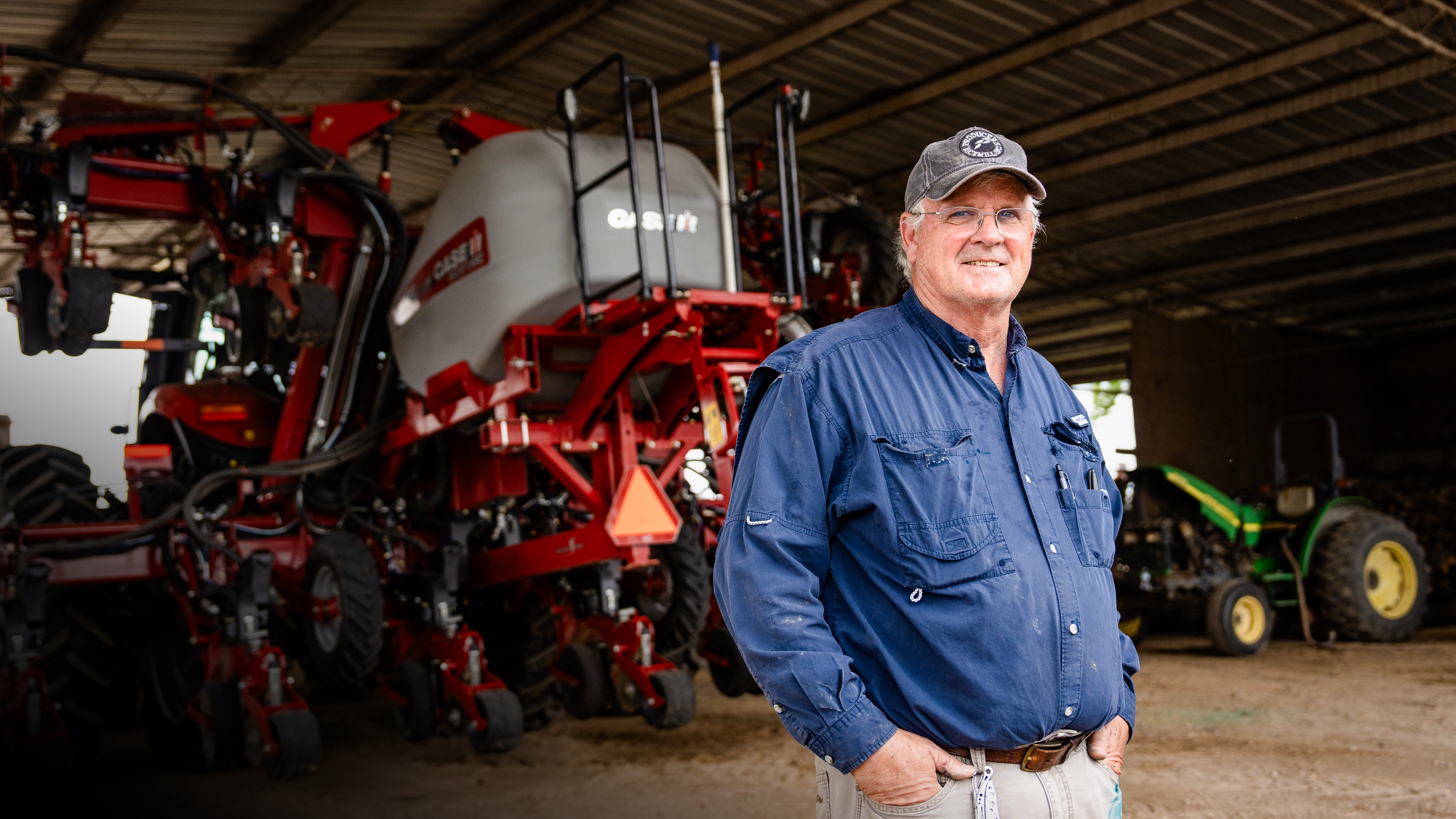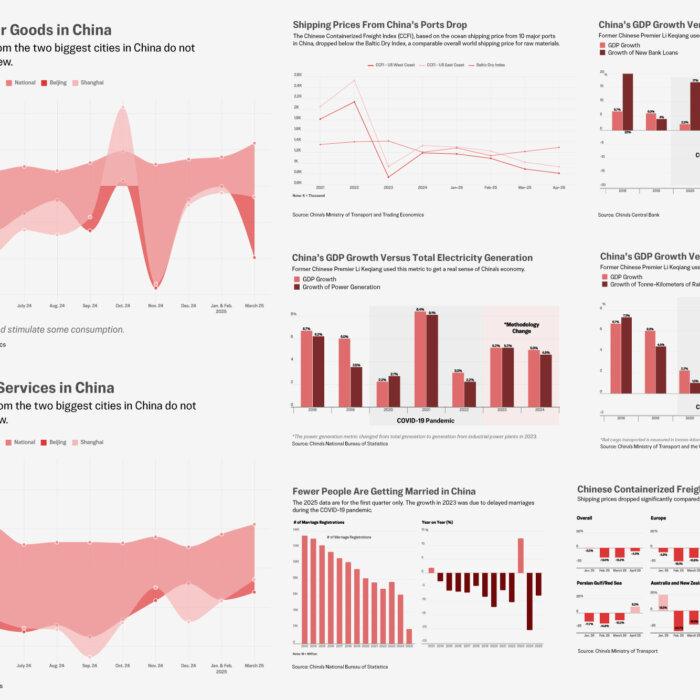LAKE VILLAGE, Ark.—On a breezy day, sun and shadow dance across Mencer farms, turning it into a patchwork of green in the fertile Arkansas Delta.
It is humid here in the deep South, where the clock seems to run slower and the temperature hotter than in other places.
Lake Village is a small town sitting along Lake Chicot, an abandoned channel of the Mississippi River. Over thousands of years, flooding deposited rich alluvial soil, making it ideal for crops like rice, cotton, soybeans, and corn.
As a child, William Mencer’s grandfather handed him a cowboy hat and a garden hoe to dig up the pigweeds growing between the crop rows.
The 31-year-old farmer remembers spending long, sweltering days alongside the farmworkers, his hands growing rough and calloused with the effort.
“So I learned, you know, what it was like for these workers,” he told The Epoch Times.
He vowed to escape the sweat and toil of the fields by going to law school and working in an office. But the family farm drew him back like a love song.
Now he is partnering with his father, Joe Mencer, to keep the farm afloat with temporary agriculture workers through the H-2A visa program.
The fourth-generation family farm, which costs $4 million per year to operate, includes 6,000 acres that they own and lease.
While some may claim agriculture needs illegal immigrants to pick crops and work the fields, Joe Mencer told The Epoch Times that they’ve never had an illegal immigrant come looking for work.
What Is the H-2A Visa?
It costs more to bring in temporary legal workers than it would if they could find enough people locally to work. But without temporary migrant workers, William Mencer said local farms would go bust, affecting the nation’s food security.The process has become much more complex since the Mencers began using the guest worker program back in the 1980s.
So much so that the younger Mencer started a small law practice helping other farmers obtain the labor they sorely needed.
He also shares his knowledge with other farmers as a member of the Arkansas Farm Bureau.
The process of hiring workers through the program, sometimes called a guest worker program, starts early in the year for the Mencer family.


The paperwork needs to be filed 60 to 75 days before their start date, which is mid- to late-February, he said.
It costs as much as $5,000 to bring in several guest workers from Mexico to the United States, he said, noting that the cost doesn’t include the housing and transportation provided to the workers.
Most return home in mid-December, but they are eligible to stay for up to three years in certain situations when agricultural work is available.
The program requires the Mencers to advertise their farm jobs locally before they can be given to guest workers.
Tangled in Red Tape
The process to petition for workers with the U.S. Citizenship and Immigration Service is antiquated, with all communications taking place via mail, according to William Mencer.The government does not offer online services, email, or a phone number. If there’s a problem, then the farm’s labor source is jeopardized because of the lack of communication, he said.
“Sometimes things get lost in the mail. You know, literally,” he said.
One of his client’s petition paperwork didn’t arrive in the mail. So they filed a claim for the lost package and resubmitted the paperwork.
This time, the paperwork made it to the Dallas office, but the postal carrier found the original package and shipped it, too.
With both petitions filed with the government, it almost took an act of Congress to clear it up.
The younger Mencer sent a letter explaining what happened with the evidence to the government officials, just like he would in court, but the office didn’t respond.
He enlisted the help of his congressman to clear things up. By the time it was all done, his client was behind by a month in getting guest workers.
It makes him wonder if the difficulty and red tape is “by design.”

The workers are so important that the Mencers keep them busy even when the weather is bad, although it doesn’t help their bottom line.
When there’s no field work, they cut firewood for use in the winter months.
Guest Worker Success
The Mencers said their farm couldn’t operate without H-2A visa workers, although the labor cost is higher than using local workers.Farmers’ margins are already slim because of increased production costs for fertilizer, herbicides, seed, and fuel.
José Mondragon, who started as an H-2A visa worker, is now a green-card holder. He has worked for the Mencer family for nearly 30 years.
Others, such as Gabino Mondragon (no relation to José Mondragon) are H-2A visa holders who have only been working at the farm for a few years.
José Mondragon lives with his wife in a little house on the farm surrounded by flowers and trees. The 57-year-old has deep roots in the land, even serving as a pallbearer when Joe Mencer’s father passed away.
In late April, he operated a self-driving orange Case Magnum row crop tractor, which plowed the earth between the corn rows to improve irrigation.
José Mondragon said he’s seen American workers quit after two or three months, long before the crops are harvested in the fall. The lack of local workers can open the door for temporary visa workers, which is good for everyone, he said.
“The people [are] asking us if we have some opportunities to come with my boss, and we say we will ask him,” he said.
José Mondragon said some people come to the United States illegally because they get into trouble with the law back home or to escape the cartels. Others come to make more money to help support their families in their native countries.


José Mondragon said human smugglers, known as coyotes, charge people big money to cross the southern border illegally.
Gabino Mondragon has been working at the Mencer farm on a guest visa for two years. He is experienced at running a spreader for nitrogen fertilizer for corn. One truckload of fertilizer can cost $20,000, according to William Mencer, so having a skilled operator is critical.
Gabino Mondragon believes that more people in Mexico would like to apply for an H-2A visa. Still, if they are caught coming into America illegally, they won’t be eligible unless they get a waiver. It would depend on their record.
The Mencers brought Gabino Mondragon’s family over on an H-4 visa so they could live close by while he worked.
The H-4 nonimmigrant visa allows the spouse and unmarried children younger than 21 years of age to accompany the primary visa holder to the United States.
It’s also an excellent opportunity for Gabino Mondragon’s family because his children are going to school and learning English.
Hanging by a Thread
The high cost of labor, diesel, and chemicals is making it extremely difficult for family farms to stay in business, according to William Mencer.“We’ve been in four or five really bad years now,” he said.
Some farmers are faced with losing their farms to foreclosure by banks over crop production loans, finding a different line of work, or selling out.
Operations are expensive. A modern tractor costs half a million dollars, driven in part by Environmental Protection Agency (EPA) regulations that add $35,000 to the cost, according to Joe Mencer.
Diesel fuel costs $41,000 per month, and the labor bill is another $44,000 per month.
A cotton harvester costs more than $1 million. Equipment and operating costs are fixed, but the commodity prices can dip below the break-even point, according to the Mencers.

Right now, the farm stands to take a loss on cotton, which is bringing in 18 cents per pound less than what it costs to produce.
So many things can go wrong—not enough rain or too much rain, storms, and equipment breakdowns.
Technology can help: Soil analysis can tell farmers what crops will grow best in each field, and machines can calculate the rate at which seeds should be spread to maximize growth. Drones can help with pesticide and herbicide applications.
Joe Mencer said they do all they can to diversify the business and cut corners. He coats his own seeds with fungicide because it saves him money. Likewise, he invested in grain silos to hold rice and corn to increase his profit.
He holds his corn until December, when the demand for chicken feed increases and he can get the best price.
Politics on the Farm
“Congress needs to do something about trying to make this an easier process to get foreign workers,” William Mencer said. “That’s a win, win.”Aspects of food and crop production—such as meat and poultry processing—should be opened up for guest workers, he said. It would lower costs and bolster legal immigration at the same time.
Moving the guest worker program under the Department of Agriculture would help because the department’s leaders understand the demands of farmers, he said.
His father said that Congress desperately needs to pass a new farm bill to help farmers hit hard by higher production costs. The farm bill expired in 2023 but has been extended into 2025,
As the chairman of the Arkansas Agriculture Council, Joe Mencer has sounded the alarm on Capitol Hill and with Secretary of Agriculture Brooke Rollins.
A new farm bill that considers the increased cost of production could help farmers financially if the commodities market falls too low.
Farmers believe in safety and clean food and water, but overregulation is one more straw on the camel’s back, he said.
“I never thought I'd need a lawyer until a few years ago. It’s been so good to have him back here helping,” Joe Mencer said of his son.
Others echoed that sentiment at a February hearing held by the Senate Committee on Agriculture, Nutrition, and Forestry.
Bret Erickson, chairman of the U.S. Government Relations Council for the International Fresh Produce Association and senior vice president for J&D Produce in Texas, testified before the committee that his company hired 500 to 600 seasonal workers, mainly through the H-2A visa program—but at a high cost.

“Labor costs remain the biggest threat to the future of U.S. fresh produce growers in Texas. Our labor costs have essentially doubled in just five years,” he said.
“We’re currently at $23 an hour for our cost,” he said.
Mexico pays its workers $18 per day.
He complained about the overregulation of pesticides and herbicides, noting that the Environmental Protection Agency (EPA) is phasing out many chemicals, leaving few viable alternatives for producers.
Empty Breadbasket?
Joe Mencer said what’s more concerning is that people seem to have forgotten where their food comes from or believe that America can import everything and grow nothing.“A lot of people said we don’t need farms in the U.S.,” he said. “We can bring all of our food in from somewhere else.”
Worldwide, there is about a 90- to 120-day food supply, he said. The entire world, not just the United States, would be vulnerable if a catastrophe occurred.
He worries about the future of farming. He sees more and more farmers getting out every year. Sometimes the banks won’t finance them because they lost money over the past few years, or they’re faced with literally putting their farm on the line as collateral and losing them altogether.
Many have just decided to do something else for a living or sell out to one of the big foreign or American conglomerates buying up farmland.
“They are killing America as we know it, the fabric of America,” William Mencer said. “It is so important to America as a whole, you know, keep family farms going—and we’re losing that.”


















